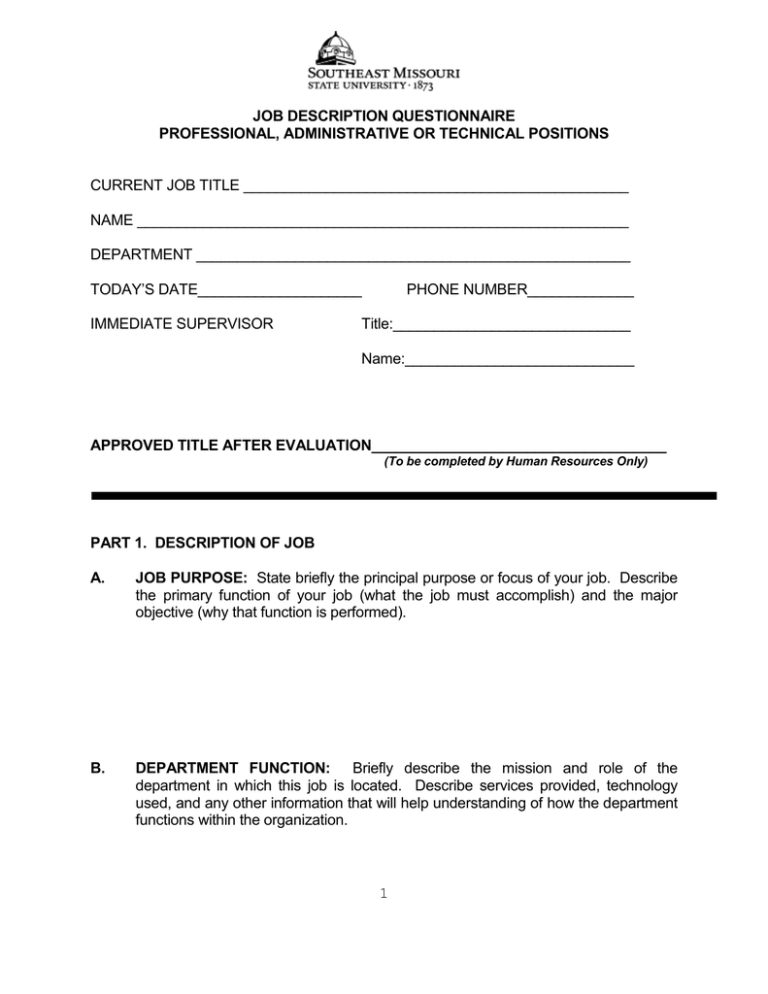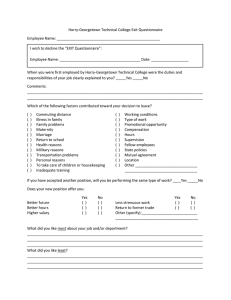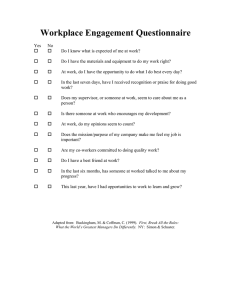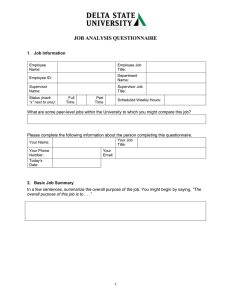CURRENT JOB TITLE _______________________________________________ NAME ____________________________________________________________ JOB DESCRIPTION QUESTIONNAIRE
advertisement

JOB DESCRIPTION QUESTIONNAIRE PROFESSIONAL, ADMINISTRATIVE OR TECHNICAL POSITIONS CURRENT JOB TITLE _______________________________________________ NAME ____________________________________________________________ DEPARTMENT _____________________________________________________ TODAY’S DATE____________________ IMMEDIATE SUPERVISOR PHONE NUMBER_____________ Title:_____________________________ Name:____________________________ APPROVED TITLE AFTER EVALUATION____________________________________ (To be completed by Human Resources Only) PART 1. DESCRIPTION OF JOB A. JOB PURPOSE: State briefly the principal purpose or focus of your job. Describe the primary function of your job (what the job must accomplish) and the major objective (why that function is performed). B. DEPARTMENT FUNCTION: Briefly describe the mission and role of the department in which this job is located. Describe services provided, technology used, and any other information that will help understanding of how the department functions within the organization. 1 C. ORGANIZATIONAL STRUCTURE: Show in detail the organizational structure above and below your job. Identify each job or group of jobs by title and number of incumbents. Type name here Type title here Your organization reports to: You report to: Type name here Type title here Other jobs reporting to the same supervisor are: Indicate organizational structure under your job: D. QUANTITATIVE DATA: Indicate important scope data which affect how you do your job and demonstrates its size or effect on the organization. State all figures on an annual basis. Estimated numbers are satisfactory. 1. Dollar Measures: e.g., unit payroll, project budgets, capital expenditures, accounts payable or receivable, relevant expenses, volume purchases, premium income, sales etc. ITEM ANNUAL AMOUNT 2 2. Unit Measures: e.g., number of projects supervised, number of subordinate personnel, number of requests processed, number of applications processed, etc. ITEM ANNUAL AMOUNT 3. Total operating budget for which you are held accountable (if any). 4. Any other scope measurements pertinent to your job. ITEM E. ANNUAL AMOUNT PRINCIPAL ACTIVITIES: List five to eight statements which describe only the major activities for which your job is accountable. Do not list all individual tasks or steps necessary to achieve the end results but stress the end result itself. For each activity, state in three separate sections (a) "What is done" (action), (b) "How it is done" (method) and (c) "Why is it done" (result). WHAT IS DONE HOW IT IS DONE 3 WHY IT IS DONE F. PRINCIPAL CHALLENGES: Describe the nature and variety of the most typical and the most complex problems you face in this job and your long- and short-range challenges: 1. Typical Problems: 2. Most Complex Problems: 3. Challenges: G. SPECIAL PROJECTS: If your job involves special projects or analyses, describe one to three characteristic assignments. Describe the nature of the project, your role in the study and the major projected results of the project. H. FUNCTIONAL GUIDANCE: duties. Most jobs receive guidance in carrying out their 4 I. 1. List those jobs other than your immediate superior that provide you with work leadership. Briefly discuss the nature and purpose of the guidance. 2. List those jobs other than your subordinates to which you provide work leadership. Briefly discuss the nature and purpose of that guidance. AUTHORITY AND RESPONSIBILITY: Identify the types of decisions that you have the power to make on your own, as well as those which must be referred to a superior. In both cases, include authority for decisions regarding issues of policy and procedure, administrative matters and personnel (hiring, firing, salary increases, etc.) 1. What typical decisions do you have total authority for making without review by a superior or senior level job? 5 2. J. What typical decisions do you refer to other for approval? To whom do you refer the decision? What is the nature or input? KEY CONTACTS: Many jobs require contact with other sources to accomplish tasks such as gathering information or ensuring coordination. These sources are considered key contacts. 1. What are the most significant professional contacts you have within the organization? Describe approximately how often per month they occur and their purpose. Consider only contacts other than your immediate supervisor or subordinates. Contacts may be individuals (by title) or groups (departments, task forces, committees, etc.). CONTACT 2. FREQUENCY PURPOSE What (by title or group) are the most significant job-related contacts you have outside the organization? CONTACT FREQUENCY 6 PURPOSE K. PERFORMANCE MEASUREMENT: Every job has aspects that can be measured to gauge how well in incumbent has performed. List four to seven key end results to be achieved by your job that would provide an appropriate basis for evaluating your performance. PART II. KNOWLEDGE AND BACKGROUND REQUIREMENTS A. In column I, list the minimum requirements of knowledge and the type and length of previous experience necessary for an individual to be considered for this job. In Column II, give additional characteristics that are desirable but not essential. I. MINIMUM II. DESIRABLE, BUT NOT ESSENTIAL B. What aspects of this job take the longest to learn and why? C. List the professional licensing and/or certifications required for this job. 7 D. Describe the typical career path an individual would take to gain the experience and skills necessary for this job. What sequence of education and previous jobs would best prepare the individual? PART III. GENERAL A. Describe any significant factors important to this job that are not covered elsewhere: e.g., special assignments, involvement in committees and/or membership in outside organizations. B. Describe those facets of your job that depend on creativity and/or generation of new ideas. C. Describe unique conditions that govern your work such as externally imposed deadlines (as opposed to deadlines set by your superior), excessive work volume, etc. 8 D. Describe your general working conditions. What is the environment in which work is performed? To what degree does the job require exertion or physical effort? PART IV. REVIEW BY SUPERVISOR (To be completed by incumbent's immediate supervisor) It is essential that you review thoroughly the contents of this questionnaire and complete the sections below. This is not a performance appraisal for the individual, but a review of the content and accuracy of this questionnaire. A. What do you consider the most important responsibilities of this job? B. What do you see as the key end results of this job that most accurately indicate the incumbent's performance? C. In what areas would you normally assist an incumbent with guidance and advice to achieve the job's objectives. D. List those activities which require approval by you or others before the employee can take action. E. What knowledge, skills and abilities and experience do you consider to be most critical for this job? F. Comment on the accuracy and completeness of this questionnaire. Add any items that will make the questionnaire more complete. 9 Questionnaire completed by: (Please sign) _____________________________________ Employee Date Contents approved by: (Please sign) _____________________________________ Immediate Supervisor Date Contents approved by: (Please sign) _____________________________________ Dean, Dir., Department Head Date Contents approved by: (Please sign) _____________________________________ Vice President/Provost Date IMPORTANT: Significant differences between the supervisor's view of the job and the employee's view should be discussed and resolved prior to submission of the questionnaire. 10


